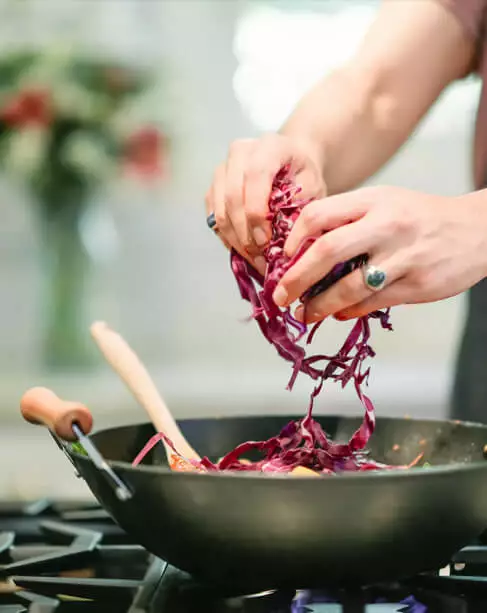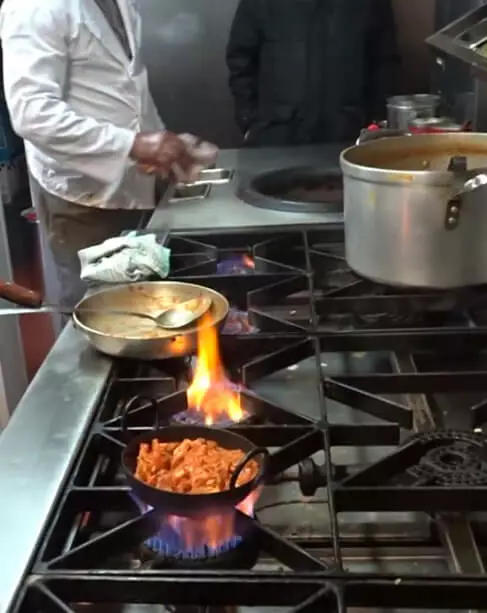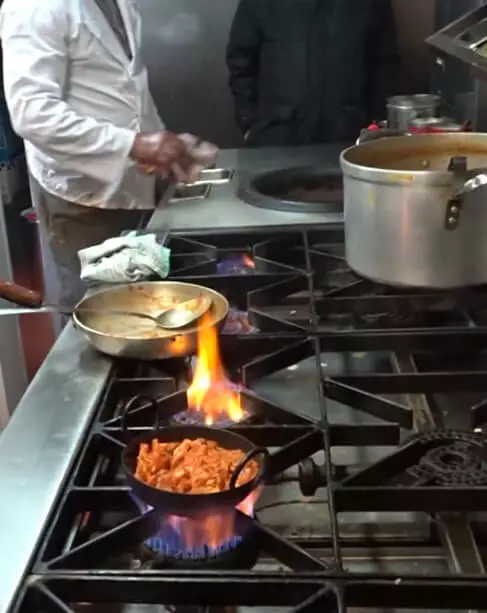What are the uses of an LPG
connection?

Most households use a gas connection for their cooking needs.
अधिकांश परिवार अपनी खाना पकाने की जरूरतों के लिए गैस कनेक्शन का उपयोग करते हैं।

Some of their even use it for other requirements like heating.
उनमें से कुछ भी हीटिंग जैसी अन्य आवश्यकताओं के लिए इसका उपयोग करते हैं।

Some machines in warehouses run of the same LPG gas, however, they would have to pay higher prices for the same.
गोदामों में कुछ मशीनें उसी एलपीजी गैस से चलती हैं, हालांकि, उन्हें उसी के लिए अधिक कीमत चुकानी होगी।

Some benefits of using LPG over traditional fires
LPG makes cooking easy, fast and reasonably priced. It is a clean and efficient gas with several benefits:

-
Easier Administration
LPG is easy to control since the stoves come with an instant on and off switch, working at the twist of a knob. In addition, the adjustment of the amount of fuel needed can be manipulated, unlike wood or dung fires of the past where people usually had a standard amount of heat.
-
Faster Cooking
Using LPG to cook is a lot faster than other fuels because of its high calorific value. Moreover, since you can adjust the flame for the best results.
-
Keeping your kitchen cool
LPG stoves emit less heat generally and more targeted heat. This means that the food you intend to heat up, would, but the rest of the area would remain reasonably cooler than a previous kitchen using a wood/dung fire.
-
Environment Friendly
LPG creates the least greenhouse gas emission of all the available fossil fuels. It contains very less amount of Sulphur, Nitrogen and other particulate matters that are harmful to the environment. Cooking with LPG can help reduce the greenhouse gas emission by up to 70%.
-
Clean Kitchen
It is easy to store an LPG cylinder in the kitchen as it occupies little space. Unlike traditional cooking fuels like firewood, charcoal and kerosene, LPG does not leave ash, soot or harmful smoke.
-
Economical & Safe
LPG is an economical fuel. LPG stoves and burners require less maintenance as compared to other cooking forms. LPG is convenient and safe to use.

What is the process of getting
a connection?
Getting a gas connection is getting easier with each passing day. A majority of the Indian population already receives cooking gas for their needs. They handle this through gas bottles or cylinders that are home-delivered, in most cases. In some parts of rural India, people have to travel to the gas depot and collect their gas cylinders.
Getting a gas connection does take some time but with the proper documentation and a little persistence, you can get it in about a month. Before we get into the details of a gas connection, we have to mention that a giant chunk of rural India still uses wood, twigs, branches, dung and other such sources for their fuel. This is then used to cook and to light up fires for other purposes like heat and so on. Post knowing this, it is safe to say that using cooking gas, also called LPG (liquid petroleum gas ) is a safer and cleaner alternative to their cooking needs.
What are the documents needed to handle
the application process?
Proof of identity (Anyone of the following)
- Voter identification card
- Passport
- Driving license
- PAN card
- Any photo identification issued by the State Government
- Aadhaar number allotment letter
For proof of address (Anyone of the following)
- Voter identification card
- Ration card
- Electricity bill (not more than three months old)
- Telephone bill (not more than three months old)
- Employers certificate
- Rent receipt (last two months)
- Flat allotment letter
- House registration papers
- Aadhaar number allotment letter.
If you are applying for a connection, some
of the most popular LPG cylinder providers in India are

Bharat Petroleum Corporation Limited
While not only dealing with natural gas, Bharat Petroleum also works with oil for a variety of needs. Bharatgas, one of BPCL’s seven business units, is engaged in marketing LPG and propane for industries, hotels, malls, IT parks, automobiles, etc. Bharatgas also offers industrial services, including customer advisory services, energy audits, e-banking, consultancy & technical services, fuel management systems, etc. to organizations that need them. Bharatgas powers over 42 million homes and has brought many innovative products and customer-centric offerings to the customers.

Hindustan Petroleum Corporation
While not only dealing with natural gas, Bharat Petroleum also works with oil for a variety of needs. Bharatgas, one of BPCL’s seven business units, is engaged in marketing LPG and propane for industries, hotels, malls, IT parks, automobiles, etc. Bharatgas also offers industrial services, including customer advisory services, energy audits, e-banking, consultancy & technical services, fuel management systems, etc. to organizations that need them. Bharatgas powers over 42 million homes and has brought many innovative products and customer-centric offerings to the customers.

Indane is a Liquefied Petroleum Gas (LPG) brand developed and owned by Indian Oil Corporation. It is the world’s second-largest LPG marketer. The brand came about more than half a century ago in 1964 to bring modern cooking to Indian kitchens. The first Indane LPG connection was released in 1965 at Kolkata. Indane serves more than 90 million families through a network of 9100 distributors. 27% of its customers reside in semi-urban or rural markets and every second LPG cooking gas connection in India is an Indane connection, awarding them the title of “Superbrand” by Superbrand India.
Indane began operations in October 1965, with two dealerships in Kolkata and Patna, with about 2,000 customers. At that time the concept of cooking gas was new to the customers and they were apprehensive of keeping a gas cylinder in their kitchens, perceiving it as unsafe and a potential hazard. More than 50 years later, Indane now has a customer base of more than 98 million and its distribution network delivers more than 2 million LPG cylinders in a day.
Who can get an LPG connection?
Every Indian family (either urban or rural) can get an LPG connection. However, one family can avail of only one LPG connection from any of the three suppliers.
What are the various types of LPG connections?
- LPG connection for domestic use (14.2 Kg and 5 Kg)
- LPG connection for commercial use (For Hotel/ Restaurant,Industry, etc) (19 Kg and 47.5 Kg)
Getting a connection online
The online method is a lot more convenient allowing applicants to upload
content as and when convenient for them. All additional documentation
would have to be scanned or photographed and uploaded to the website.
The fees can be handled online as well. The gas connection book would be
ready and can be collected in a week, allowing candidates to start
purchasing their gas bottles. The scans would be the same as the offline
method.
You can use the links below to begin the process:
Improvements being made to natural gas in India
Gas in many parts of the country has been moved from the cylinders to the pipeline. This makes the entire system a lot more convenient and better monitored. Gas was initially being used for cooking with an additional amendment being made for industrial and commercial use. In multiple instances, people were using cylinders for commercial use while paying domestic prices which was causing an issue.
A lot of the Indian metros have already begun the migration and are seeing results. Others have begun implementing procedures to assist with the move. Overall, the Government would earn a good amount of revenue when systems like gas and electricity are better streamlined and monitored. This is easier with the meter system where each house would have a meter and would have to pay based on the amount that they consume.

Gas pricing in various Indian cities for
the 14.2 kg cylinders
- New Delhi₹ 574.00
- Kolkata₹ 600.00
- Mumbai₹ 547.00
- Chennai₹ 950.00
- Gurgaon₹ 644.50
- Noida₹ 634.50
- Bangalore₹ 650.00
- Bhubaneswar₹ 663.00
- Chandigarh₹ 585.50
- Hyderabad₹ 700.00
- Jaipur₹ 626.50
- Lucknow₹ 612.00
- Patna₹ 730.00
- Trivandrum₹ 634.50
Benefits of LPG for Vehicle

- Make sure the gas cylinder is kept vertically and not leaning on any side horizontally. This could cause gas leakages and other issues that could have dangerous effects.
- Make sure the valve of the cylinder is not in line with the flame from the stove. This could be dangerous and could be the cause of unnecessary fires.
- Make sure that the area where the cylinder is stored is away from the stove or lower.
- Clean your valves and burners regularly to avoid blocks and leaks.
- Whenever you are done using the stove, especially before bed or if leaving the house for a holiday, turn off the valve to avoid leaks.
- When purchasing a cylinder, make sure that it is sealed. If it is not, there is a chance that it might have been used by someone else. Many even verify their cylinder weight to make sure it has been loaded to the right amount.
- Do not light fires really close to the valves of the cylinder if it is connected to the stove.
Summing up
Indane, Hindustan Petroleum and Bharat Gas are the largest producers of LPG in India. Although the rest are building a presence in the Indian market, they are usually working with Industries in commercial uses and would take some time to pick up in the domestic sector.
If you are looking for a gas connection, sign up for one now. After submitting all your
documentation, you should have one within 30 days.





